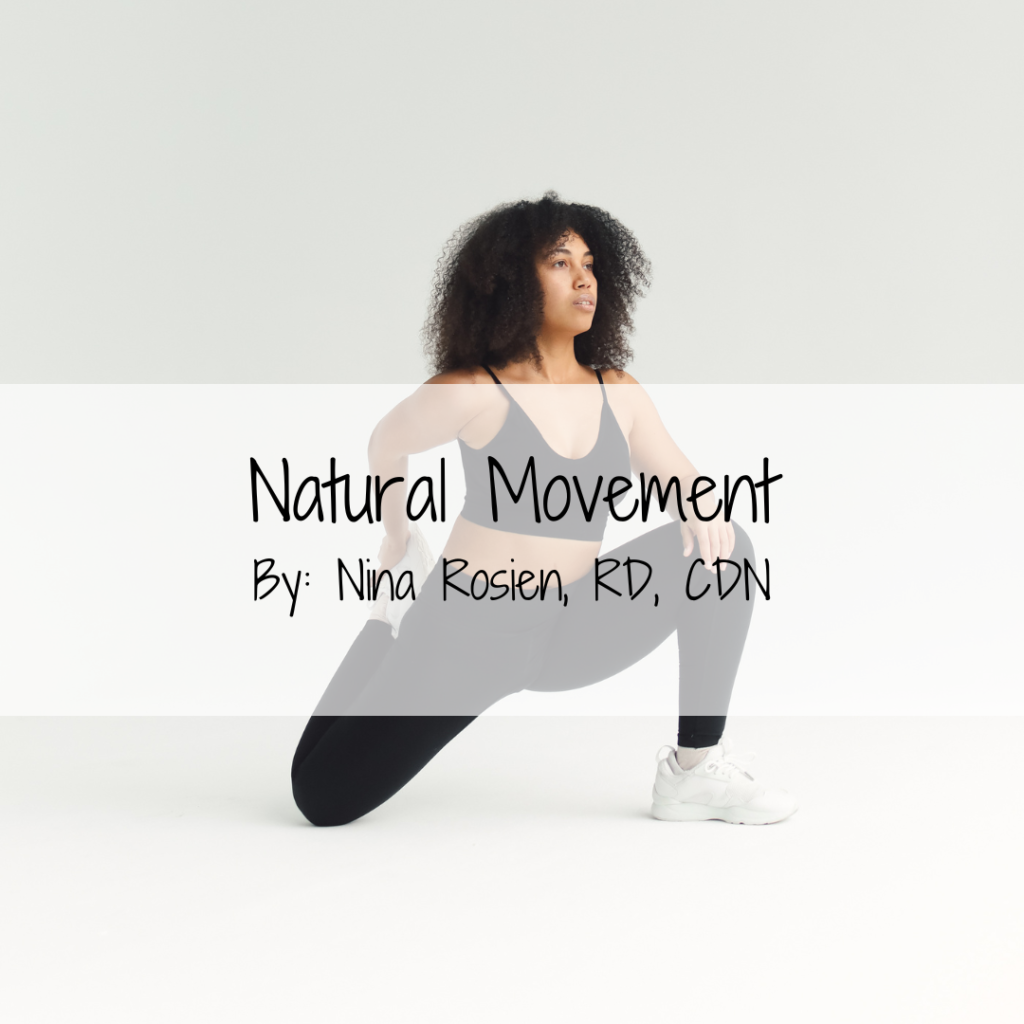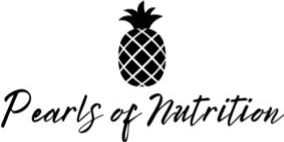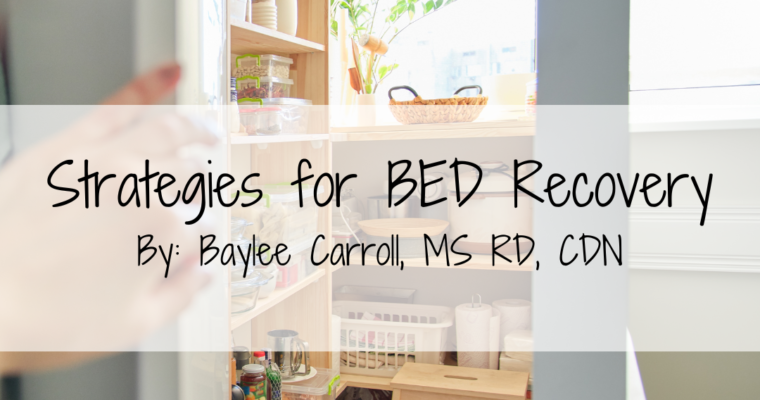
*Please note- for readers struggling with disordered eating and/or compulsive exercise: this article may not apply to you and may negatively impact your recovery. Proceed with caution.*
Get moving! That’s probably something that you’ve heard before, maybe your watch is buzzing telling you to get more steps, or it’s something that you tell yourself on a day where you feel really confined to your computer at work. You’ve had back to back virtual meetings, and then next thing you know you haven’t stood up in 3 hours. A common recommendation we hear in all this noise about physical activity is how we should include more exercise in our lives. An easy way to accomplish this is via natural movement, and it actually has an impact on our health in a variety of ways.
As a Certified Personal Trainer (CPT), I was surprised to learn that there was value in moving in different ways. The one way people are most familiar with is exercise. Exercises are specific activities programmed and executed towards specific outcomes. For example, a trainer may create a fitness regime to prepare someone for a marathon, or you may go to a local community center to try a pilates class. This contributes to the thermic effect of activity, which is a fancy way of saying burning energy through exercise. Movement on the other hand refers to all physical activity other than what the body does to keep itself alive at rest. That includes everything from doing the laundry to playing tag with your niece, and walking to the store. Not all movement is exercise, but all exercise is movement.
This can be further explained by NEAT. NEAT is non-exercise activity thermogenesis. Levels of NEAT may vary tremendously, and may contribute up to 20% of expending energy. Some research has suggested that higher levels of daily NEAT may act as preventative measures against chronic illnesses. Making a concerted effort to accumulate NEAT throughout the day, such as taking the stairs instead of an elevator, can meaningfully contribute to overall metabolism. Thus, finding ways of incorporating more movement in natural forms can be extremely beneficial. While NEAT is not a replacement for regular exercise, it’s still hugely beneficial for our physical and mental health, and can help decrease sedentary behaviors.
Also being a Registered Dietitian, I am always curious about how movement can impact our bodies biologically. We’re seeing more and more in research how movement and activity play a role in a variety of different clinical conditions. Incorporating intuitive movement is also one of the principles of intuitive eating. Intuitive movement is the practice of connecting and listening to your body to figure out how it feels and what type of movement it naturally needs that day. Unfortunately, the common dialogue around exercise is what we “should do” and this mentality can be particularly pervasive in those that struggle with disordered eating. Shifting to a more intuitive approach would be using your body’s internal cues to determine the best type of movement, and choosing to move your body for the purpose of self-care or health benefits instead of doing it to lose weight or burn calories. Practicing intuitive movement, rather than forcing exercise, can help you nurture a healthier relationship with movement and your body.
To further look at the health benefits of movement and how it relates to the body, let’s start with the brain and work our way down.
The brain-
- Improve sleep- More movement throughout the day has been shown to potentially decrease insomnia and have less disrupted sleep patterns.
- Shift mood – Movement has been shown to have many wellbeing benefits. That’s because a wide variety of movements have been shown to shift the effects of hormones associated with positive emotions, like serotonin and dopamine. These result in increased experiences of pleasure, accomplishment, meaning, sense of self, and other aspects of wellbeing far outside the movement itself.
- Delay cognitive decline – Similarly, increases in movement have been shown to delay neurodegeneration and increase multiple brain functions.
- Connection and purpose – Movement can also be a driver for connection and community. Physical activities create an event or series of events to meet new people, socialize with those you already know, and do things you like together to build feelings of relatedness. Joining a recreational softball league, taking a tap dancing class online, or hiking with your church group are all examples of movement connecting with others. This can increase our feelings of connection and improves emotional wellbeing.
- Decrease stress – Moving our bodies increases stress tolerance and shifts our mind’s association of the sensations of stress. For example, an increased heart rate from working out is similar to the increase in heart rate you experience with anxiety. By learning to associate it with movement, you’re able to relate to the sensation in a different, more positive way.
The heart-
- Blood flow – The heart is composed of cardiac muscle, and the strength of the heart is directly correlated to its ability to circulate oxygenated blood throughout the body. More movement throughout the day stimulates blood flow to and from the heart, and works towards improvement in heart health, specifically blood pressure.
The gut-
- Stimulates bile – Walking before or after a meal, and incorporating natural movement, can stimulate bile. Bile is a really important part of our GI system, and not always for the reason we expect. Bile acts as an antimicrobial coating the lining of our digestive tract, in addition to digesting fat.
- Promotes good gut bacteria – There is some research that suggests a variety of regular movement may increase gut microbial diversity and promote the growth of symbiotic bacteria populations, especially movement that involves your core.
- Decreasing constipation – While our bodies have a natural ability to keep food moving along our GI tract through peristalsis, continuing to add in movement throughout the day can help decrease constipation, gas pains and cramps by moving things along our GI tract.
Incorporating more movement in your day can be a way to decrease the pressure to have structured exercise daily. Again, those that struggle with exercise compulsion and/or disordered eating should use caution. We encourage you to speak with your Registered Dietitian about the appropriate level of movement for you. For those of you in need of more natural movement, here are some ways to start:
- Try a standing desk – This can be a way to improve posture and core strength as well! Also make sure you have proper footwear if you choose to include more standing in your day as standing in improper footwear can increase low back pain and hip and knee discomfort.
- Stand up and stretch during phone calls – need to catch up with a friend out of town? Try going for a walk during your next “catching up” phone call, standing, or incorporating some stretching during your conversation.
- Commercial break – Incorporate stretching or bathroom breaks when your favorite TV show has a commercial break, or as a pause between episodes.
- Stay hydrated – drinking water has its own variety of benefits. And staying hydrated also tends to correlate with more bathroom breaks, which creates more movement in your day.
- Try other gaming methods – if you like to play video games, try some newer ones that cause you to get up and move more such as VR boxing, Wii fit, or dance centered video games.
- Do outside chores – in upstate New York, there’s typically something to do outside each season; shoveling snow, raking leaves, pulling weeds, mowing the lawn, etc.
- Using the stairs – at your next doctor’s visit, try using the stairs to get to the office instead of using the elevator
- Walking meetings – next time you have a meeting and the weather agrees, try making it a walking meeting instead!
- Keep up with laundry – try doing laundry every other day versus one day a week. Splitting it up throughout the week can be a way of spreading out movement throughout each day.
- Incorporate some play – aim to get outside when you take your dog out, or adding in some play time with your kiddo that incorporates some movement
Lastly, think about your favorite ways of moving! If you really enjoy being outdoors, walking a little longer to class or work may feel more motivating because of that. Or if you love hanging with your pup, make it a point to add in movement that includes them too!
*PLEASE NOTE: It is best to work with your certified personal trainer on proper progression of exercises. The examples above are basic recommendations meant for educational purposes only. Please be sure to check with your doctor before beginning any physical activity.
It is also important to check in with your Registered Dietitian prior to starting additional exercise, especially for those in eating disorder recovery. We want to make sure exercise is safe for your place in recovery and you are fueling your body adequately to fuel any additional movements.
https://blog.nasm.org/movement-for-emotional-wellbeing
Some content obtained from from:
NASM Certified Personal Trainer, 7th Edition


